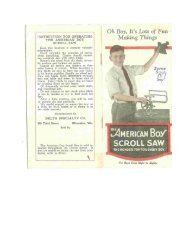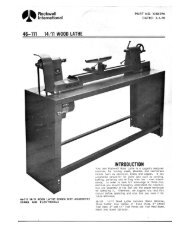You also want an ePaper? Increase the reach of your titles
YUMPU automatically turns print PDFs into web optimized ePapers that Google loves.
The gouge is placed on edge on the tool rest in such<br />
a position that the grind of the chisel forms an approximate<br />
right angle with the work, as shown in Figs.<br />
77 and 78. The chisel contacts the work at the center<br />
of the cutting edge, the tool being held so that the<br />
centerline of the gouge is pointing directly towards<br />
the center of the revolving stock, as shown in Fig. 79.<br />
This starting position is important; otherwise the<br />
gouge wi II have a tendency to run along the surface<br />
of the work.<br />
From the starting pQsition, the gouge is pushed into<br />
the revolving stock, and the tool is rolled on the rest.<br />
A triple action takes place here: First, the chisel<br />
is rolled to follow the shape of the cut; second, the<br />
handle is dropped slightly so that the portion already<br />
cut will force the lip of the chisel sidewise; third,<br />
the chisel is pushed forward so that at the end of the<br />
cut, Fig. 80, it wi II be well up on the work and tangent<br />
with the cut surface. Only one-half of the cut is made<br />
at one time, then the chisel is reversed to cut the<br />
other half. The occasional turner is advised to make<br />
cove cuts with a scraping technique, using either<br />
the small gouge or round nose chisel.<br />
19<br />
Fig80<br />
MAKING n4E<br />
C.OVI; ~UT<br />
SQUARE SECTIONS. When the turning has a square<br />
section, the stock should be jointed before turning.<br />
Good centering is essential since any error will show<br />
at the shoulder where the round meets the squ~re.<br />
Turning of the shoulder from square to round can be<br />
done in various ways, one method being pictured in<br />
Figs. 81, 82, 83 and 84. If the parting tool is sharp,<br />
the nicking cut with skew, Fig. 81, can be omitted.<br />
The final trimming operation Fig. 84, can be done<br />
with either the skew or spear chisels. This is a scraping<br />
operation. While the shoulder can be cut with<br />
the same technique used for cutting a bead, the simpler<br />
scraping method pictured d oos clean work and is easier<br />
to do.<br />
Fig 84<br />
--<br />
~W~~~o~H8~~'ki~








